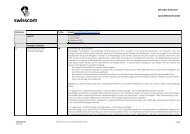Shareholders' Letter
Shareholders' Letter
Shareholders' Letter
You also want an ePaper? Increase the reach of your titles
YUMPU automatically turns print PDFs into web optimized ePapers that Google loves.
in the balance sheet separately under current assets and liabilities. The assets or asset groups are<br />
valued at the lower of their carrying amount and fair value less costs of disposal and any impairment<br />
losses arising resulting from the initial classification are recorded in the income statement.<br />
Assets classified as held for sale and disposal groups are no longer depreciated and amortised.<br />
3.11 Impairment losses<br />
Impairments of financial assets<br />
As of each balance sheet date, the carrying amount of those financial assets for which changes in<br />
fair value are not recognised in the income statement are reviewed for any objective indications<br />
of impairment in value. An impairment loss is recognised where there is objective evidence of<br />
impairment, such as where the borrower is in bankruptcy, in default or other significant financial<br />
difficulties. The impairment of a financial asset which is recorded at amortised cost is calculated<br />
as the difference between its carrying amount and the present value of estimated future cash<br />
flows, discounted at the asset’s original effective interest rate. Available-for-sale financial assets<br />
whose fair value is less than their acquisition cost for a prolonged period or to a significant degree<br />
are considered to be value impaired. In the event of impairment, the losses are reclassified out of<br />
equity and recognised as financial expense. As of each balance sheet date, significant financial<br />
assets are individually reviewed for impairment. Impairment losses on trade and other receivables<br />
are recorded in the form of specific valuation allowances which cover the anticipated default risk.<br />
As regards lump-sum valuation allowances, financial assets are regrouped on the basis of similar<br />
credit risk characteristics and reviewed on a collective basis for impairment in value; where applicable,<br />
an allowance is raised. In determining the anticipated future cash flows of the portfolio, historic<br />
default rates are taken into account in addition to the contractually agreed payment conditions.<br />
Impairment losses on trade and other receivables are recognised as other operating<br />
expenses. Impairment losses on other financial assets are recorded as financial expense.<br />
In the event of impairment in the value of available-for-sale financial assets, the cumulative losses<br />
which had been previously recognised in equity are reclassified from equity and expensed. If, at a<br />
subsequent balance sheet date, the fair value objectively increases as a result of events occurring<br />
after the impairment loss was recognised, the previously recognised impairment loss is reversed<br />
in an equivalent amount. The reversal of impairment losses for financial assets accounted for at<br />
amortised cost is recognised in the income statement. In the case of equity instruments classified<br />
as available-for-sale, the recovery in value is recognised directly in equity.<br />
Impairment of goodwill<br />
For the purposes of the impairment test, goodwill is allocated to cash-generating units. The impairment<br />
test is performed in the fourth quarter after completion of business planning. If there is any<br />
indication during the year that goodwill may be impaired, the cash-generating unit is tested for<br />
impairment at that time. An impairment loss is recognised if the recoverable amount of a cashgenerating<br />
unit is lower than its equivalent carrying amount. The recoverable amount is the<br />
greater of the fair value less costs to sell and the value in use. The method used to test impairment<br />
is described in Note 24. Any impairment loss on goodwill recognised in prior periods for goodwill<br />
may not be reversed in subsequent periods.<br />
Impairment of property, plant and equipment and other intangible assets<br />
If indications exist that the value of an asset may be possibly impaired, the recoverable amount<br />
of the asset is determined. If the recoverable amount of an asset, which is the greater of the fair<br />
value less cost to sell and the value in use, is less than its carrying amount, the carrying amount<br />
is reduced to the recoverable amount.<br />
3.12 Leases<br />
Finance leases<br />
A lease is recorded as a finance lease when substantially all of the risks and rewards incidental to<br />
ownership of an asset are transferred. The asset is initially recorded at the lower of its fair value<br />
and the present value of the minimum lease payments and is amortised over the lesser of the<br />
asset’s useful life and the lease term. The interest component of the lease payments is recognised<br />
as interest expense over the lease term using the effective interest method. Leases for land and<br />
buildings are recorded separately if the lease payments can be reliably allocated accordingly. Gains



